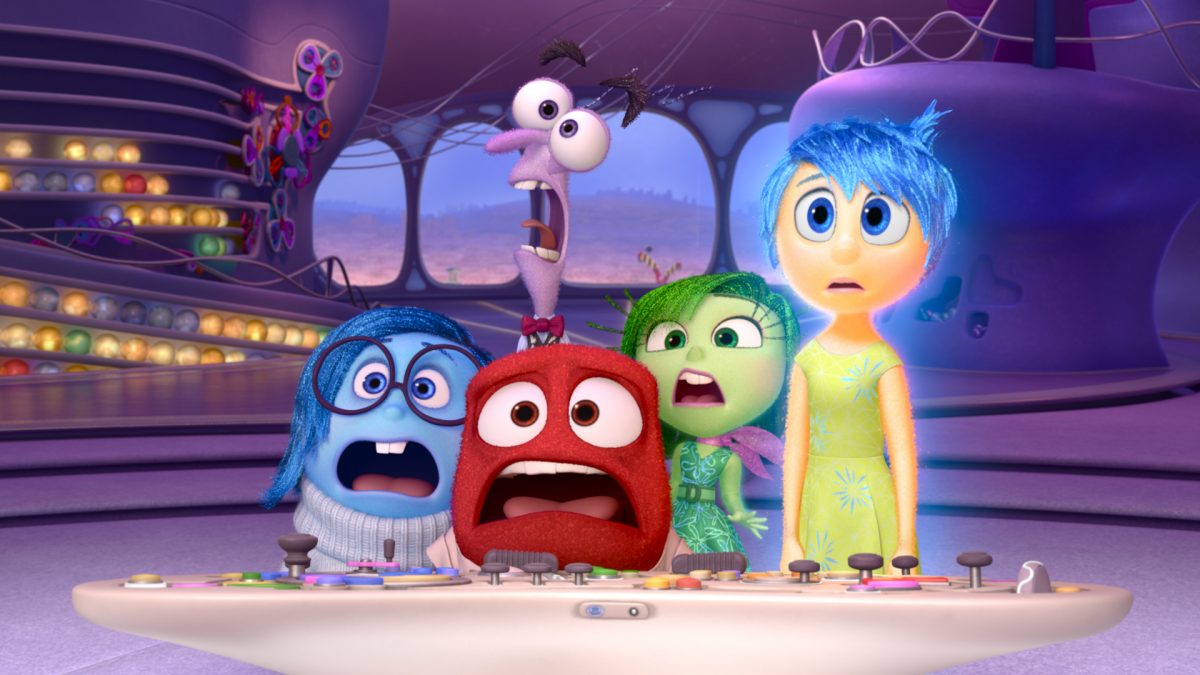
When you’re a little kid, assuming you had a stable upbringing, your emotions are pretty simple. There’s the comfort of family. There’s the elation of running, recklessly, through the house. There’s the grossness of broccoli, quickly appeased when it is delivered via dad’s “choo-choo train.” There’s some pain and some fear and confusion, too, but joy is pretty much your default state.
That is certainly the case for Riley (the voice of Kaitlyn Dias), the little girl at the center of Inside Out. In the “headquarters” of her mind, it is Joy (Amy Poehler) who clearly rules the roost.
Those wizards of Pixar have taken us to many wonderful places: Under the sea, inside the secret world of toys and monsters and bugs, behind the scenes at a French restaurant. But Inside Out, which is co-directed by Pete Docter and Ronaldo Del Carmen, may be their most inventive film yet. In the film’s world, the mind is a giant ecosystem consisting of emotions who live in headquarters—along with Joy, there’s Sadness (Phyllis Smith), Disgust (hilarious Mindy Kaling), Anger (who else, but Lewis Black), and Fear (Bill Hader)—plus a complex network of personality “islands”, core memories, ideas, feelings, and subconscious thoughts and dreams.
Everything is totally groovy in Riley’s life in Minnesota. She has her best friend—as always, Pixar can encapsulate the joy of a friendship in a few simple images (two girls, arm in arm, skipping puddles in the rain, in this case)—and a sport she loves and is good at (hockey) and she’s really close to her parents (voiced by Kyle MacLachlan and Diane Lane).
The headquarters is a pretty happy place, too, with Joy as the undeniable top dog. Then everything changes. Riley turns eleven. The family moves to San Francisco. Dad is stressed at work. The pizza tastes weird. Riley misses her friends. No one cares about hockey. And suddenly, Joy and Sadness are catapulted out of headquarters and have to navigate the vast terrain of Riley’s mind to get back. Along the way, they encounter Riley’s old imaginary best friend, a part-elephant, part-dolphin named Bing Bong (a loveable Richard Kind), who tries to help them.
My God, the brilliance of this! To take life’s first hardship, the first time the happy-go-lucky default of childhood is truly tested, and to turn it into an elaborate adventure involving Joy and Sadness trying to find their way home blends everything Pixar does so well: anthropomorphizing unlikely things and evoking our deepest emotions. Poehler is wonderful at Joy, making her a genuinely game and funny companion (not the grating cheerleader she could’ve been) and both the animation of Sadness—a roly-poly blue girl with serious looking glasses—and Phyllis Smith’s expertly mopey line readings are adorable. The inclusion of silly, sweet, and slightly dumb Bing Bong, long forgotten by our tweenage Riley, will remind you a bit of the discarded toys of Toy Story—but that doesn’t mean he will break your heart any less. The adventures themselves are funny and surreal—at one point, literally surreal—and the film shows us just enough of Riley and her parents and her life at school to be really invested in her as a person. Just for fun, the film occasionally takes us inside the minds of Riley’s parents—mom is still pining for the Latin lover who got away; dad thinks about hockey a lot—or a school teacher, or, in one hilarious moment, a pubescent teenage boy who’s the equivalent of the “Squirrel!” dog from Up, only with girls.
Now, you might ask yourself: Why is Sadness along for the ride with Joy? Isn’t Joy really what Riley needs back in her life? All I can say is that Pixar’s sweet spot is poignancy. In life, Joy and Sadness often do—and arguably must—go hand in hand. In Inside Out, they do that quite literally.
